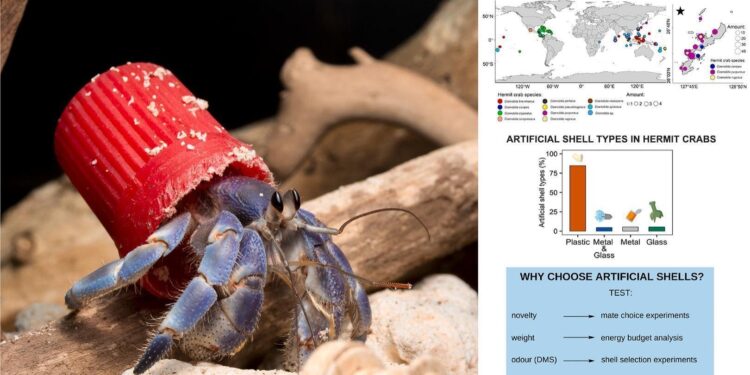Credit: Total Environmental Science (2024). DOI:/10.1016/j.scitotenv.2023.168959
Terrestrial hermit crabs are soft-bodied crustaceans that live near water in tropical regions of the world. Without any natural protection, these crabs normally find refuge in abandoned mollusk shells. But a number of terrestrial hermit crab species are beginning to opt for artificial shells, often made from plastic objects found in beach trash.
New research on this topic, described in a brief communication from a team from the Center for Biological and Chemical Research at the University of Warsaw and the Department of Zoology at the Poznań University of Life Sciences in Poland, appears in Total Environmental Science.
Plastic pollution, on the rise, already represents 85% of global marine pollution. Existing research shows that most of the plastic pollution in Earth’s oceans arrives there via rivers, leading to a buildup of plastic waste on coastlines.
Terrestrial hermit crabs (Coenobitidae) live on all tropical coasts of the world and commonly acquire empty gastropod shells to protect their soft abdominal region, known as the pleon. The shells protect them from predators and also prevent their pleon from drying out.
Studies of shell selection by crabs have shown that key factors include chemical signals gleaned from shells; proximity to predators; shell quality; and the growth rate of individual crabs. Shells have also been shown to play a role in sexual signaling, as the size and condition of male crabs’ shells affects females’ mate choice.
Coenobita purpureus with artificial shells: (A) plastic cap, (B) bulb fragment, (C) metal cap with glass bottle fragment. Credit: Shawn Miller / Total Environmental Science (2024). DOI:/10.1016/j.scitotenv.2023.168959
An iEcology approach
In this new research, the team adopted an Internet ecology (iEcology) approach. iEcology involves the study of digital content (audio recordings, videos, images, news and user activity posts) posted on news sites, social networks and other platforms to learn about events, ecological orientations and processes.
The researchers note that “although the validity of data collected on social media platforms has been easily demonstrated in the field of conservation, their application to ecology and evolution is still very limited. »
The team recognizes the work of photographer Shawn Miller, who first published images of hermit crabs using plastic waste as shells on his blog in 2014, when he discovered hermit crabs in blueberries (Coenobita purpureus) doing so on the beaches of Okinawa. It was Miller’s work that inspired this study.
iEcology survey reporting geotagged images from social media platforms confirms global presence of artificially shelled hermit crab species (n=329; for 57 observations (total n=386), geolocation n was not available). Credit: Total Environmental Science (2024). DOI:/10.1016/j.scitotenv.2023.168959
To quantify this type of hermit crab behavior, researchers examined images posted to several online platforms and combined their results with a literature review. As part of their literature review, this behavior is first described in a 2009 study published in Marine biodiversity records.
Literature review alone “revealed only four publications to date, reporting two species of terrestrial hermit crabs, three species of marine hermit crabs, and a total of 10 individuals with artificial shells,” notes the newspaper.
Following the iEcology methodology allowed the team to expand on their findings. They identified 386 individual crabs – from 10 of 16 species of terrestrial hermit crabs – with artificial shells. The vast majority of images depicted crabs using black and white plastic caps (84.5%; 326 of 386 images). Those with metal-only or glass-only shells made up 5.4% each, and the remaining 4.7% had both metal and glass shells.
It is worth noting, with regard to the images, possible confusing factors: “… due to the often contrasting color of plastic compared to other man-made or natural materials, plastic may be easier to spotting for people, thereby influencing the frequency of reporting. “Data collected through iEcology may be affected by potential biases resulting from various factors that influence data collection among observers. These factors include individual and cultural subjectivity, such as the likelihood of posting unusual behavior online,” it says. the document.
(A) Anthropogenic materials used as artificial shells by hermit crabs (n = 386). Plastic shells are the most used artificial shells (n = 326, 84.5%), followed by metal (n = 22, 5.4%), glass (n = 22, 5.4%) and metal and glass (n = 18, 4.7%). ). (B) Factors in the use of artificial shells in hermit crabs and proposed tests. Credit: Total Environmental Science (2024). DOI:/10.1016/j.scitotenv.2023.168959
Why plastic rather than natural shells?
In discussing possible reasons for this behavior in Coenobitidae, the team notes the environmental availability of plastic waste, as well as the increasing scarcity of gastropod shells due to localized human activities. Researchers also suggest factors involved in individual choice, including:
- Attractiveness of artificial materials to mating females
- Lighter artificial shells that could benefit hermit crabs’ energy
- An odor of dimethyl sulfide, present in both natural shells and marine debris; And
- The possibility that artificial shells could serve more effectively as camouflage in polluted areas, given that shell selection is often made to blend into the localized environment.
These are all topics that deserve further investigation.
The big question
“Are artificial shells setting the stage for a new evolutionary trajectory in hermit crabs, or are they an ecological and evolutionary trap of the Anthropocene?” ask the researchers.
Although this new behavior can be considered an intelligent adaptation, the main factor behind it is undeniable. With this in mind, what this habit ultimately means for the evolution of terrestrial hermit crabs remains to be studied.
More information:
Zuzanna Jagiello et al, The plastic houses of hermit crabs in the Anthropocene, Total Environmental Science (2024). DOI:/10.1016/j.scitotenv.2023.168959
© 2024 Science X Network
Quote: On tropical coasts, hermit crabs now settle in plastic waste (January 29, 2024) retrieved January 30, 2024 from
This document is subject to copyright. Except for fair use for private study or research purposes, no part may be reproduced without written permission. The content is provided for information only.



